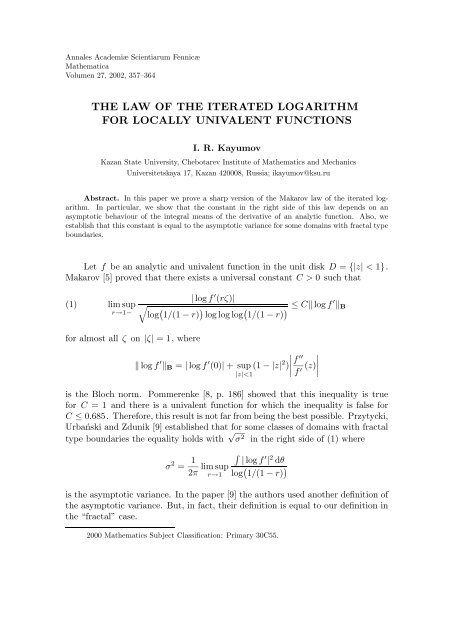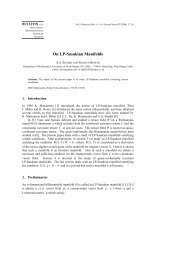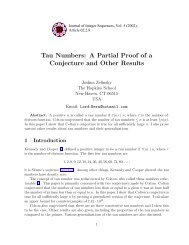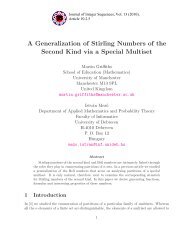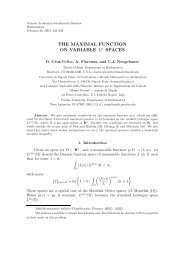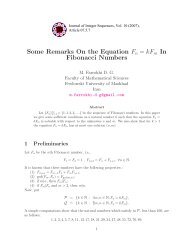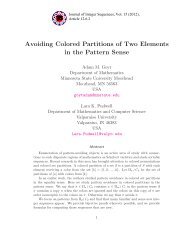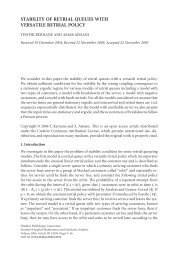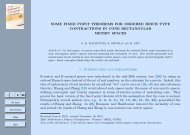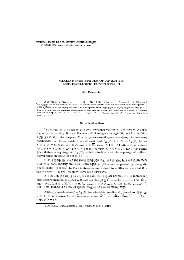the law of the iterated logarithm for locally univalent functions
the law of the iterated logarithm for locally univalent functions
the law of the iterated logarithm for locally univalent functions
You also want an ePaper? Increase the reach of your titles
YUMPU automatically turns print PDFs into web optimized ePapers that Google loves.
Annales Academiæ Scientiarum FennicæMa<strong>the</strong>maticaVolumen 27, 2002, 357–364THE LAW OF THE ITERATED LOGARITHMFOR LOCALLY UNIVALENT FUNCTIONSI. R. KayumovKazan State University, Chebotarev Institute <strong>of</strong> Ma<strong>the</strong>matics and MechanicsUniversitetskaya 17, Kazan 420008, Russia; ikayumov@ksu.ruAbstract. In this paper we prove a sharp version <strong>of</strong> <strong>the</strong> Makarov <strong>law</strong> <strong>of</strong> <strong>the</strong> <strong>iterated</strong> <strong>logarithm</strong>.In particular, we show that <strong>the</strong> constant in <strong>the</strong> right side <strong>of</strong> this <strong>law</strong> depends on anasymptotic behaviour <strong>of</strong> <strong>the</strong> integral means <strong>of</strong> <strong>the</strong> derivative <strong>of</strong> an analytic function. Also, weestablish that this constant is equal to <strong>the</strong> asymptotic variance <strong>for</strong> some domains with fractal typeboundaries.Let f be an analytic and <strong>univalent</strong> function in <strong>the</strong> unit disk D = {|z| < 1}.Makarov [5] proved that <strong>the</strong>re exists a universal constant C > 0 such that(1) lim supr→1−| log f ′ (rζ)|√log ( 1/(1 − r) ) log log log ( 1/(1 − r) ) ≤ C‖ log f ′ ‖ B<strong>for</strong> almost all ζ on |ζ| = 1, where‖ log f ′ ‖ B = | log f ′ (0)| + sup (1 − |z| 2 )|z|
358 I. R. KayumovThe goal <strong>of</strong> this paper is to obtain a sharp version <strong>of</strong> <strong>the</strong> Makarov <strong>law</strong> <strong>of</strong> <strong>the</strong><strong>iterated</strong> <strong>logarithm</strong> <strong>for</strong> <strong>locally</strong> <strong>univalent</strong> <strong>functions</strong>, i.e. <strong>for</strong> <strong>functions</strong> f <strong>for</strong> whichf ′ (z) ≠ 0, z ∈ D .Let f be a <strong>locally</strong> <strong>univalent</strong> function in <strong>the</strong> unit disk D and p be a complexnumber. Then <strong>for</strong> all δ > 0 we defineβ δ (p) =logsupr∈[0,1)[δ ∫ ]|z|=r |f ′ (z) p |dθlog ( 1/(1 − r) ) .In o<strong>the</strong>r words β δ (p) is <strong>the</strong> minimal number <strong>for</strong> whichIf p is a real number <strong>the</strong>nwhere∫|f ′p | dθ ≤ 1 δ( ) βδ (p) 1, 0 ≤ r < 1.1 − rβ δ (p) → β(p) as δ → 0,β(p) = lim supr→1log ∫ |z|=r |f ′ (z)| p dθlog ( 1/(1 − r) )is <strong>the</strong> classical integral means spectrum [8, p. 176].It follows from <strong>the</strong> integral means spectrum concept ( [2], [7], [8]) that <strong>the</strong>reis a connection between geometric properties <strong>of</strong> domains and <strong>the</strong> integral meansspectrum. On <strong>the</strong> o<strong>the</strong>r hand, Makarov [5] established that <strong>the</strong> <strong>law</strong> <strong>of</strong> <strong>the</strong> <strong>iterated</strong><strong>logarithm</strong> is closely related to <strong>the</strong> boundary properties <strong>of</strong> con<strong>for</strong>mal maps. Thisleads to <strong>the</strong> following natural question: Is <strong>the</strong>re a simple relation between <strong>the</strong> <strong>law</strong><strong>of</strong> <strong>the</strong> <strong>iterated</strong> <strong>logarithm</strong> and <strong>the</strong> integral means spectrum? A possible answer <strong>for</strong>this question is <strong>the</strong> following result which we will prove later.Suppose f is a <strong>locally</strong> <strong>univalent</strong> function in <strong>the</strong> unit disk and δ > 0. Thenlim supr→1−| log f ′ (rζ)|√log ( 1/(1 − r) ) log log log ( ) ≤ 2 lim sup1/(1 − r)p→0√βδ (p)<strong>for</strong> almost all ζ on |ζ| = 1.It is more convenient <strong>for</strong> us to <strong>for</strong>mulate this result in <strong>the</strong> <strong>for</strong>m <strong>of</strong> <strong>the</strong> followingTheorem 1. Suppose f is a <strong>locally</strong> <strong>univalent</strong> function in <strong>the</strong> unit disk. Then<strong>the</strong> following inequality holds(2) lim supr→1−| log f ′ (rζ)|√log ( 1/(1 − r) ) log log log ( 1/(1 − r) ) ≤ √ σ 2 (0+)|p|
The <strong>law</strong> <strong>of</strong> <strong>the</strong> <strong>iterated</strong> <strong>logarithm</strong> <strong>for</strong> <strong>locally</strong> <strong>univalent</strong> <strong>functions</strong> 359<strong>for</strong> almost all ζ on |ζ| = 1, whereσ 2 (δ) = 4 lim supp→0β δ (p)|p| 2 .We remark that Pommerenke’s result with <strong>the</strong> constant C = 1 easily followsfrom our <strong>the</strong>orem because it is known [3] that if log f ′ is a Bloch function <strong>the</strong>nσ 2 (0+) ≤ ‖ log f ′ ‖ 2 B . Moreover, we will see that in many casesσ 2 (0+) = σ 2 .Fur<strong>the</strong>r, it is convenient to use <strong>the</strong> following abbreviation:∫ 2π∫h(re iθ ) dθ ≡ h dθ0The next lemma can be deduced from Makarov’s pro<strong>of</strong> <strong>of</strong> <strong>the</strong> <strong>law</strong> <strong>of</strong> <strong>the</strong><strong>iterated</strong> <strong>logarithm</strong> [5].Lemma 1. Let C k be a sequence <strong>of</strong> positive numbers and C 1/kk→ 1 ask → ∞. If∫| log f ′ | 2n dθ ≤ C n n!A 2n log n 11 − r<strong>for</strong> all natural n and <strong>for</strong> all r ∈ [ 1 − exp(− exp e n ), 1 ) , <strong>the</strong>nlim supr→1−<strong>for</strong> almost all ζ on |ζ| = 1.| log f ′ (rζ)|√log ( 1/(1 − r) ) log log log ( 1/(1 − r) ) ≤ APro<strong>of</strong>. We use Pommerenke’s version <strong>of</strong> Makarov’s <strong>law</strong> [8, p. 186]. Our pro<strong>of</strong>∫is almost <strong>the</strong> same as Pommerenke’s pro<strong>of</strong>. Let us only remark that instead <strong>of</strong>∞in his pro<strong>of</strong> we have to consider ∫ ∞eexp(e n ) .Pro<strong>of</strong> <strong>of</strong> Theorem 1. Fix δ > 0 and ε > 0. Then <strong>the</strong>re exists p 0 = p 0 (δ, ε) > 0such that∫|f ′p | dθ ≤ 1 ( ) (σ 12 (δ)+ε)|p| 2 /4δ 1 − r<strong>for</strong> |p| < p 0 . This implies∫∫I 0 (t| log f ′ |) =≤ 1 δ∫12πt( 11 − r|f ′p | |dp| dθ = 1 ∫ ∫2πt |p|=t) (σ 2 (δ)+ε)t 2 /4, t ∈ (0, p 0 ),|p|=t|f ′p | d θ|dp|
360 I. R. KayumovwhereI 0 (x) =∞∑( x2k=04) k/k! 2 = 1 ∫ 2πe x cos θ dθ2π 0is <strong>the</strong> modified Bessel function <strong>of</strong> order zero [1]. At <strong>the</strong> same time,∫Setting| log f ′ | 2n dθ ≤ 4nt 2n n!2 ∫t 2 =and using <strong>the</strong> identitywe obtain∫Applying Lemma 1, we getlim supr→1−I 0 (t| log f ′ |) dθ ≤ 4n 1 ( ) (σ 12 (δ)+ε)t 2 /4t 2n n!2 .δ 1 − r4n(σ 2 (δ) + ε) log ( 1/(1 − r) ), n ≤ log log log 11 − r ,e =( 1) 1/ log(1/(1−r))1 − r| log f ′ | 2n dθ ≤ 1 δ n!2 e n 1 (σ 2n n (δ) + ε ) ( ) nn 1log .1 − r| log f ′ (rζ)|√log ( 1/(1 − r) ) log log log ( 1/(1 − r) ) ≤ √ σ 2 (δ) + ε<strong>for</strong> almost all ζ on |ζ| = 1 and <strong>for</strong> all δ > 0, ε > 0. Hence, this result is true <strong>for</strong>δ = 0+ and ε = 0. This completes <strong>the</strong> pro<strong>of</strong>.If f is a <strong>univalent</strong> function and f(D) is a domain with rectifiable boundary<strong>the</strong>n inequality (2) is trivially sharp. Non-trivial examples, which show that thisinequality is sharp, can be obtained by using lacunary series.Let log f ′ = ∑ ∞k=1 a kz n kbe a lacunary series with bounded coefficients andn k+1 /n k ≥ q > 1. Since log f ′ is a Bloch function <strong>the</strong>n σ 2 (0+) < +∞ as wasmentioned above. In <strong>the</strong> o<strong>the</strong>r direction, Makarov [6] showed that if n k = 2 k anda k = 1 <strong>for</strong> all k <strong>the</strong>n σ 2 (0+) > 0. Rohde [8] improved his result in <strong>the</strong> followingsense. Suppose q is an integer, n k = q k and a k = a > 0, <strong>the</strong>n σ 2 (0+) ≥ a 2 / log q .In [4] it was shown that if q ≥ 2 <strong>the</strong>nσ 2 (0+) = lim supr→1B 2log ( 1/(1 − r) ),where B 2 = ∑ ∞k=1 |a k| 2 r 2n k.We want to extend this result <strong>for</strong> <strong>the</strong> case q > 1. To do this we need <strong>the</strong>following
The <strong>law</strong> <strong>of</strong> <strong>the</strong> <strong>iterated</strong> <strong>logarithm</strong> <strong>for</strong> <strong>locally</strong> <strong>univalent</strong> <strong>functions</strong> 361Definition ([10]). We say that a lacunary series satisfies condition (ϱ, R) ifit consists <strong>of</strong> blocks <strong>of</strong> terms <strong>of</strong> length R, separated by empty blocks <strong>of</strong> length ϱ.Weiss [10] proved <strong>the</strong> followingLemma 2. Let f(z) = ∑ ∞k=1 a kz n kbe a lacunary series satisfying condition(ϱ, R), where(q ϱ/3 − 1) −1 ≤ 1 4 (q − 1) and q−R/3 (R + 1) 2 ≤ 1 2 .Let M = sup |a k |, B 2 = ∑ ∞n=1 |a k| 2 r 2n k, r ∈ [0, 1). Then∫πe (1−ctR2 )t 2 B 2 /4 ≤ e t Re f(reiθ) dθ ≤ 3πe (1+ctR2 )t 2 B 2 /4 .Denote by ϱ 0 <strong>the</strong> minimal positive number <strong>for</strong> which(q ϱ 0/3 − 1) −1 ≤ 1 4 (q − 1) and q−ϱ 0/3 (ϱ 0 + 1) 2 ≤ 1 2 .Now, we can prove <strong>the</strong> followingTheorem 2. Let log f ′ = ∑ ∞k=1 a kz n kbe a lacunary series with boundedcoefficiens <strong>for</strong> which n k+1 /n k ≥ q > 1. Thenσ 2 (0+) = lim supr→1B 2log ( 1/(1 − r) ),where B 2 = ∑ ∞k=1 |a k| 2 r 2n k.Pro<strong>of</strong>. It is clear that we can represent log f ′ as f 1 + f 2 , where f 1 satisfies<strong>the</strong> (ϱ 0 , R)-condition and f 2 satisfies <strong>the</strong> (R, ϱ 0 )-condition. Let us estimate B12and B2 2 . In fact, it is enough to estimate only B 2 because B 2 = B1 2 + B2 2 . WehaveB 2 ≤ M 2∞∑j=1j(R+ϱ 0 )∑∑ ∞r 2qk ≤ M 2 ϱ 0k=jR+(j−1)ϱ 0 j=1r 2qRj≤ C log11 − r /R.Evidently, without loss <strong>of</strong> generality, we can assume that p = t is a real positivenumber. Setting R = t −2/5 , we have∫ ∫(∫) 1/α (∫1/β|f ′ | t dθ = e t Re f 1+t Re f 2dθ ≤ e αt Re f 1dθ e βt Re f 2dθ),where β = t −1/5 and α = (1 − t 1/5 ) −1 . Applying Lemma 2 with f 1 and f 2 and<strong>the</strong> estimate <strong>for</strong> B 2 we obtain∫( ) Ct2+1/5|f ′ | t dθ ≤ Ce B2 t 2 /4 1.1 − rAnalogously,This concludes <strong>the</strong> pro<strong>of</strong>.∫|f ′ | t dθ ≥ Ce B2 t 2 /4 (1 − r) Ct2+1/5 .
362 I. R. KayumovApplying <strong>the</strong> <strong>law</strong> <strong>of</strong> <strong>the</strong> <strong>iterated</strong> <strong>logarithm</strong> <strong>for</strong> lacunary series [10] it is easyto show that ifB 2limr→1 log ( 1/(1 − r) )exists <strong>the</strong>n <strong>the</strong> equality in (2) holds. O<strong>the</strong>r examples which show that (2) is sharpcome from <strong>the</strong> <strong>the</strong>ory <strong>of</strong> Julia sets. The idea <strong>for</strong> using Julia sets in <strong>the</strong> <strong>the</strong>ory <strong>of</strong><strong>univalent</strong> <strong>functions</strong> is due to Carleson and Jones [2]. They conjectured that <strong>the</strong>basin <strong>of</strong> attraction <strong>of</strong> infinity <strong>for</strong> an iteration z 2 + c <strong>for</strong> some c maximizes β 0+ (1)in <strong>the</strong> class Σ.Let F (z) = z q + a q−1 z q−1 + · · · be a polynomial <strong>of</strong> degree q ≥ 2 andbe <strong>the</strong> basin <strong>of</strong> attraction <strong>of</strong> ∞ <strong>for</strong> F .Ω = {ζ : F on (ζ) → ∞ as n → ∞}Theorem 3. Let Ω be a simply connected John domain. Thenσ 2 (0+) = σ 2 = lim supr→1B 2log ( 1/(1 − r) ),where B 2 = ∑ |a k | 2 r k ; a k are <strong>the</strong> coefficients <strong>of</strong> log f ′ and f is <strong>the</strong> con<strong>for</strong>malmapping from D − = {|ζ| > 1} onto Ω.Pro<strong>of</strong>. Our main idea is an approximation <strong>of</strong> <strong>the</strong> function log f ′ by lacunaryseries. Letψ(ζ) = log F ′( f(ζ) ) ∑q−1qζ q−1 =k=1log f(ζ) − ζ kζ∞∑= b j ζ −j .j=0It is known [7] thatlog f ′ (ζ) = −∞∑ψ(ζ qk ) = ϕ(ζ) + g(ζ),k=0where g(ζ) = ∑ ∞ ∑ ∞j=N+1 k=0 b jζ −jqk and ϕ(ζ) = ∑ N ∑ ∞j=0 k=0 b jζ −jqk . Fixingε > 0, we will show that <strong>the</strong>re exists N = N(ε) such that |ζg ′ (ζ)| ≤ ε/(|ζ| 2 − 1).From Pommerenke’s result [8, p. 100] it follows that ∑ ∞j=0 |b jk| 2 j 1+α < +∞ <strong>for</strong>John domains, where b jk are <strong>the</strong> Taylor coefficients <strong>of</strong> log(f(ζ) − ζ k )/ζ . This
The <strong>law</strong> <strong>of</strong> <strong>the</strong> <strong>iterated</strong> <strong>logarithm</strong> <strong>for</strong> <strong>locally</strong> <strong>univalent</strong> <strong>functions</strong> 363implies that ∑ ∞j=0 |b j| 2 j 1+α < +∞ <strong>for</strong> John domains. There<strong>for</strong>e, we have∞∑ ∞∑∞∑ ∞∑|ζg ′ (ζ)| = | jq k b j ζ −jqk | ≤ jq k |b j |R −jqk≤k=0 j=N+1√∞∑ √√√q kk=0≤ ε N,α≤ ε N,α=∞∑k=0∑∞∞∑j=N+1k=0ε N,α∑ ∞(1 − r) α/2j 1+α |b j | 2 √ √√√k=0 j=N+1∞∑j=N+1q k R −qk(1 − R −qk ) α/2 = ε N,αq k r qk(1 − r) α/2 q αk/2 r αqk /2k=0∞∑k=0q (1−α/2)k r (1−α/2)qkj 1−α R −2jqkq k r qk(1 − r qk ) α/2≤ C ε N,α1 − r , where r = 1 R < 1.So, <strong>the</strong>re exists N = N(α, ε) such that |ζg ′ (ζ)| ≤ ε/(|ζ| 2 − 1). Consider now∫∫(∫ ) 1/p (∫1/s|f ′ (Re iθ )| t dθ = |e ϕ | t |e g | t dθ ≤ |e ϕ | pt dθ |e g | dθ) st ,where s = 1/ε, p = 1/(1 − ε).Since |ζg ′ (ζ)| ≤ ε/(|ζ| 2 − 1) <strong>the</strong>n it follows from <strong>the</strong> result <strong>of</strong> Clunie andPommerenke [3] that∫( ) t 12 /4|e g | st dθ ≤ C.R − 1It is easy to see that ϕ is a lacunary series with Hadamard gaps. ApplyingTheorem 2 to this series we see that∫|e ϕ | pt dθ ≍where( 1R − 1) t 2 p 2 σ 2 ϕ +O N (t 2+1/5 ),σϕ 2 = 1∫|ϕ| 2 dθlim sup2π R→1 log ( 1/(R − 1) )Thus,∫( ) t 12 (σ 2|f ′ (Re iθ )| t ϕ +O(ε))+O N (t 2+1/5 )dθ ≤ C.R − 1Arguing as above, we obtain∫( ) t 12 (σ 2 ϕ +O(ε))+O N (t 2+1/5 )|f ′ (Re iθ )| t dθ ≥ C.R − 1Obviously, σ ϕ → σ as ε → 0. Hence, σ(0+) 2 = σ 2 .
364 I. R. KayumovCorollary. Let Ω be a simply connected John domain. Then| log f ′ (Rζ)|lim √log ( 1/(R − 1) ) log log log ( 1/(R − 1) ) = √ σ 2 (0+)R→1<strong>for</strong> almost all ζ on |ζ| = 1.Pro<strong>of</strong>. This <strong>for</strong>mula immediately follows from Theorem 3 and <strong>the</strong> well-known<strong>law</strong> <strong>of</strong> <strong>the</strong> <strong>iterated</strong> <strong>logarithm</strong> <strong>for</strong> Julia sets [9]:| log f ′ (Rζ)|lim √log ( 1/(R − 1) ) log log log ( 1/(R − 1) ) = √ σ 2 .R→1Note also that this equality follows from <strong>the</strong> classical <strong>law</strong> <strong>of</strong> <strong>the</strong> <strong>iterated</strong> <strong>logarithm</strong><strong>for</strong> lacunary series [10]. There<strong>for</strong>e, we see again that (2) is sharp.Acknowledgements. I want to thank Pr<strong>of</strong>essors Christian Pommerenke, StephanRuscheweyh and Richard Furnier <strong>for</strong> <strong>the</strong>ir useful remarks, and Pr<strong>of</strong>essor FaritAvkhadiev <strong>for</strong> helpful discussions.This work was supported by <strong>the</strong> German Academic Exchange Service (DAAD,University <strong>of</strong> Würzburg) and by Russian Fund <strong>of</strong> Basic Research (Grants N 99-01-00366, 99-01-00173).References[1] Abramowitz, M., and I. Stegun: Handbook <strong>of</strong> Ma<strong>the</strong>matical Functions. - Dover, NewYork, 1972.[2] Carleson, L., and P.W. Jones: On coefficient problems <strong>for</strong> <strong>univalent</strong> <strong>functions</strong> andcon<strong>for</strong>mal dimension. - Duke Math. J. 66, 1992, 169–206.[3] Clunie, J., and Ch. Pommerenke: On <strong>the</strong> coefficients <strong>of</strong> <strong>univalent</strong> <strong>functions</strong>. - MichiganMath. J. 14, 1967, 71–78.[4] Kayumov, I.R.: The integral means spectrum <strong>for</strong> lacunary series. - Ann. Acad. Sci. Fenn.Math. 26, 2001, 447–453.[5] Makarov, N.G.: On <strong>the</strong> distortion <strong>of</strong> boundary sets under con<strong>for</strong>mal mappings. - Proc.London Math. Soc. 51, 1985, 369–384.[6] Makarov, N.G.: A note on integral means <strong>of</strong> <strong>the</strong> derivative in con<strong>for</strong>mal mapping. -Proc. Amer. Math. Soc. 96, 1986, 233–235.[7] Makarov, N.G.: Fine structure <strong>of</strong> harmonic measure. - St. Petersburg Math. J. 10, 1999,217–268.[8] Pommerenke, Ch.: Boundary Behaviour <strong>of</strong> Con<strong>for</strong>mal Maps. - Springer-Verlag, Berlin,1992.[9] Przytycki, F., M. Urbanski, and A. Zdunik: Harmonic, Gibbs, and Hausdorff measureson repellers <strong>for</strong> holomorphic maps. I. - Ann. <strong>of</strong> Math. 2, 1989, 1–40; II, StudiaMath. 97, 1991, 189–225.[10] Weiss, M.: On <strong>the</strong> <strong>law</strong> <strong>of</strong> <strong>the</strong> <strong>iterated</strong> <strong>logarithm</strong> <strong>for</strong> lacunary trigonometric series. - Trans.Amer. Math. Soc. 91, 1959, 444–469.Received 10 September 2001


